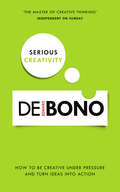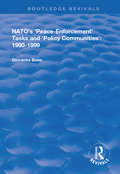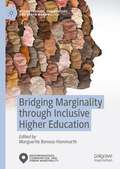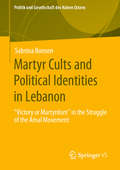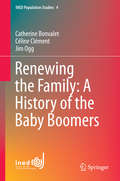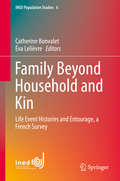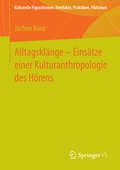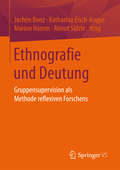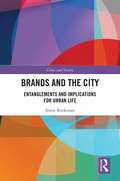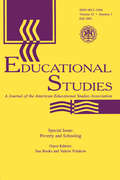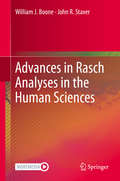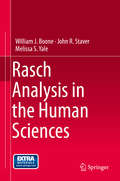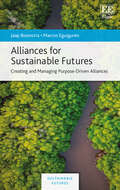- Table View
- List View
Serious Creativity: How to be creative under pressure and turn ideas into action
by Edward De BonoIf you want to be the best, focus on your most valuable asset: the power of your creative mindAs competition and the pace of change intensify, companies and individuals need to harness their creativity to stay ahead of the field. Under pressure, people often think they can't be creative; many more are convinced they are not creative at all because they have never been 'arty'. Creative genius Edward de Bono debunks these common notions in this remarkable book. He shows how creativity is a learnable skill - one that everyone can use to improve their performance. He then explains how you can unlock your own creativity to reap the personal and professional rewards it will bring. Learn how to:be creative on demand with de Bono's step-by-step approach add value to ideas and turn them into financial assets boost creativity with the power of lateral thinking break free from old ways of thinking with creative challenging
NATO's Peace Enforcement Tasks and Policy Communities
by Giovanna BonoThis book was published in 2003.How has NATO managed to survive and transform itself into a peace-enforcement organization? Challenging the dominant assumption that NATO intervened in the Balkans because of the threat that conflicts in the region posed to European security, this book develops a new set of research questions based on the hypothesis of the existence of "policy communities". The author demonstrates that there were shifting policy communities in operations that shaped the Alliance's transformation process, arguing that NATO would not have succeeded in assuming peace-enforcement tasks without other factors - ranging from organisational dynamics, domestic politics and the impact of ad hoc reactions to external events - coming into play. Highlighting the role of NATO as an actor in international security, this volume is aimed at academics and practitioners in the field of international relations
NATO's Peace Enforcement Tasks and Policy Communities
by Giovanna BonoThis book was published in 2003.How has NATO managed to survive and transform itself into a peace-enforcement organization? Challenging the dominant assumption that NATO intervened in the Balkans because of the threat that conflicts in the region posed to European security, this book develops a new set of research questions based on the hypothesis of the existence of "policy communities". The author demonstrates that there were shifting policy communities in operations that shaped the Alliance's transformation process, arguing that NATO would not have succeeded in assuming peace-enforcement tasks without other factors - ranging from organisational dynamics, domestic politics and the impact of ad hoc reactions to external events - coming into play. Highlighting the role of NATO as an actor in international security, this volume is aimed at academics and practitioners in the field of international relations
Bridging Marginality through Inclusive Higher Education (Neighborhoods, Communities, and Urban Marginality)
by Marguerite Bonous-HammarthThis book examines the changing influences of diversity in American higher education. The volume offers evidence and recommendations to positively shape inclusive learning and engagement of students, faculty, staff and community across the complex terrains of urban, suburban, and rural organizations within higher education today. Chapters highlight critical collaborations across student affairs and academic affairs, and delve into milestones addressing access, retention, engagement, and thriving within distinctive institutional types (e.g., research, liberal arts, community colleges, Minority Serving Institutions). Authors also explore the nuanced changes occurring against the contemporary backdrop of COVID-19 experiences – including the rise of anti-Asian racism, the salience of implicit biases, and the disparate access to and impacts of health services. Essential chapters refocus our consideration about the trajectories of historically underrepresented groups and their peers (including, African Americans, Hispanic/Latino, Indigenous people, individuals with disabilities and those identifying as LGBTQ+, undocumented students, and women) in American higher education.
Martyr Cults and Political Identities in Lebanon: "Victory or Martyrdom" in the Struggle of the Amal Movement (Politik und Gesellschaft des Nahen Ostens)
by Sabrina BonsenSabrina Bonsen sheds light on political cults of martyrs in Lebanon and reconsiders the context of their emergence, development and distinct characteristics since 1920. She examines how the honouring of martyrs became an established practice in Lebanese politics and is crucial to grasp the logic of violence and conflict. Drawing on the case of the Amal movement, the author analyses central narratives to the group’s discourse and practices concerning martyrdom to show how identity construction and strategies of legitimizing power are intertwined. Moreover, the book provides insides into political competition strategies, especially in regards to the two major Shiʿite political actors, Amal and Hizbullah, and takes a new look on martyrdom by going beyond cultural-religious explanations.
Renewing the Family: A History of the Baby Boomers (INED Population Studies #4)
by Catherine Bonvalet Céline Clément Jim OggThis book traces the history of the baby-boomers, beginning with an explanation of the cause of the post-war baby boom and ending with the contemporary concerns of ageing boomers. It shows how the baby-boomers challenged traditional family attitudes and adopted new lifestyles in the 1960s and 1970s. Drawing on 90 interviews conducted with baby boomers living in London and Paris, the book demonstrates how their aspirations for leisure and consumption converged with family responsibilities and obligations. It shows how the baby boomers emerged from an authoritative upbringing to challenge some of the traditional assumptions of the family, such as marriage and cohabitation. The rise of feminism led by the baby-boomers is examined, together with its impact on family forms and structures. The book shows how women’s trajectories veered between the two extremes of family and employment, swerving between the models of stay-at-home mother and working woman. It demonstrates how new family configurations such as solo parenting, and recomposed families were adopted by the baby boomers. Today, as they enter into retirement, the baby-boomers remain closely involved in the lives of their children and parents, although relationships with elderly parents are maintained primarily through a sense of duty and obligation. The book concludes that the baby boomers have both been influenced by and actors to the changes and transformations that have occurred to family life. They reconciled and continue to reconcile, individualism with family obligations. As grandparents often with an ageing parent still alive, the baby boomers wish to keep the independence that has been the hallmark of their generation whilst not abandoning family life.
Family Beyond Household and Kin: Life Event Histories and Entourage, a French Survey (INED Population Studies #0)
by Catherine Bonvalet Eva LelièvreThis book analyzes the family and residential trajectories of men and women across the twentieth century, which are placed in a long-term generational perspective and in the historical context where they played out. It brings together a set of studies based on data from the Biographies et Entourage (Life Event Histories and Entourage) survey conducted by the Institut National d’Etudes Démographiques (INED) on a representative sample of nearly 3,000 residents of the Paris region born between 1930 and 1950. Inside, readers will discover an insightful analysis of the family that moves away from such traditional concepts as the household or main residence and proposes new ones like the entourage and the residential system. This innovative approach to the family network describes an affective and residential proximity that takes into account the relatives and close friends who have played or continue to play a role in an individual's life. The book first presents a detailed analysis of the Biographies et Entourage survey respondents' parental universe and proposes a practical approach to the notion of parenthood that reveals the family and non-family resources available to individuals. Next, it describes the evolution of the respondents' family networks, both in and beyond the household, and details how these family circles shape their subjective judgments during childhood, adolescence, and adult life. Coverage then goes on to examine the family ties of older adults, the role of grandparents and step-families, the importance of family spaces including often frequented places, and inter-generational family solidarity. Families extend well beyond the walls of the home. Interpersonal relations are constructed throughout the life course and in all the settings where they play out. This book takes this new family reality into account and traces its dynamics across time and space. It provides essential tools for researchers looking to conduct life event history surveys and to develop innovative areas of research in the social sciences.
Alltagsklänge – Einsätze einer Kulturanthropologie des Hörens (Kulturelle Figurationen: Artefakte, Praktiken, Fiktionen)
by Jochen BonzVon der Frage geleitet, wie die Gegenwartskulturforschung aus der Berücksichtigung klanglicher Phänomene Erkenntnisgewinne ziehen kann, verknüpft die Studie Überlegungen aus Popkultur- und Soundscape-Forschung, Empirischer Kulturwissenschaft, Musikethnologie, Kulturtheorie und Medienwissenschaft zu einem kulturanthropologischen Forschungsansatz. Sie nähert sich ihren Phänomenen interpretativ und erprobt ein begriffliches Instrumentarium, das die subjektivierenden Effekte klanglicher Medialität benennbar macht. Auf diese Weise entwirft die Studie eine Vorstellung vom Forschungsstand kulturwissenschaftlich orientierter Sound Studies und ihren Möglichkeiten.
Ethnografie und Deutung: Gruppensupervision als Methode reflexiven Forschens
by Jochen Bonz Katharina Eisch-Angus Marion Hamm Almut SülzleEthnografische Feldforschung hat das anspruchsvolle Ziel, Annäherungen an das Wirklichkeitserleben und die alltäglichen Handlungspraxen anderer Menschen zu ermöglichen. Der Forschungsprozess zeichnet sich durch eine Komplexität aus, die selbst für qualitative empirische Sozialforschung ungewöhnlich ist; die gewonnenen Daten sind sehr vielschichtig. Die ethnografische Gruppensupervision für Feldforschende ist eine Antwort auf diese Herausforderungen. Der Band stellt dieses Instrumentarium zur Reflexion und Auswertung ethnografischer Feldforschungen in Form von methodologischen Erläuterungen und konkreten Praxisbeispielen vor.
Brands and the City: Entanglements and Implications for Urban Life (Cities and Society)
by Sonia BookmanFrom commercial retail environments to branded urban villages, brands are now a salient feature of contemporary cityscapes and are deeply entwined in people’s everyday lives. Drawing on extensive empirical material and recent theoretical developments in the sociology of brands, this book explores the complex relationship between brands, consumption and urban life. Covering a range of brands and branding in the city, from themed retail stores to branded cultural quarters, it considers how brands provide new ways of mediating identities, lifestyles and social relations. At the same time, the book reveals how brands are bound up with forms of socio-spatial division and exclusion in the city, defining what kinds of practices, images or attitudes are acceptable in a particular place, constituting cultural boundaries that keep certain people and activities out. With attention throughout to the social and cultural implications of the presence of brands in urban space, Brands and the City examines how people engage with brands, and how brands shape urbanites’ experiences and sense of self, society and space. An extensive exploration of the processes through which brands are integrated into cities, their effects on everyday experiences and their role in the policing and governance of urban space, this book will appeal to scholars across the social sciences with interests in urban studies, consumption and branding.
Brands and the City: Entanglements and Implications for Urban Life (Cities and Society)
by Sonia BookmanFrom commercial retail environments to branded urban villages, brands are now a salient feature of contemporary cityscapes and are deeply entwined in people’s everyday lives. Drawing on extensive empirical material and recent theoretical developments in the sociology of brands, this book explores the complex relationship between brands, consumption and urban life. Covering a range of brands and branding in the city, from themed retail stores to branded cultural quarters, it considers how brands provide new ways of mediating identities, lifestyles and social relations. At the same time, the book reveals how brands are bound up with forms of socio-spatial division and exclusion in the city, defining what kinds of practices, images or attitudes are acceptable in a particular place, constituting cultural boundaries that keep certain people and activities out. With attention throughout to the social and cultural implications of the presence of brands in urban space, Brands and the City examines how people engage with brands, and how brands shape urbanites’ experiences and sense of self, society and space. An extensive exploration of the processes through which brands are integrated into cities, their effects on everyday experiences and their role in the policing and governance of urban space, this book will appeal to scholars across the social sciences with interests in urban studies, consumption and branding.
New A-Level Sociology: AQA Year 1 & 2 Complete Revision & Practice (PDF)
by Cgp BooksThis clear, concise Complete Revision & Practice book from CGP is a perfect way to prepare for the AQA A-Level Sociology exams - it covers every topic and optional topic from both years of the course. It’s fully up-to-date for the new courses starting in 2015 and beyond, with straightforward study notes explaining all the theory, plus summaries of every sociological study students will need to score a top grade. Practice questions and exam-style questions are included for every topic, and the book is rounded off with a section of in-depth advice on how to do well in the exam.
Invisible Children in the Society and Its Schools (Sociocultural, Political, and Historical Studies in Education)
by Sue BooksThe authors in this book use the metaphors of invisibility and visibility to explore the social and school lives of many children and young people in North America whose complexity, strengths, and vulnerabilities are largely unseen in the society and its schools. These “invisible children” are socially devalued in the sense that alleviating the difficult conditions of their lives is not a priority—children who are subjected to derogatory stereotypes, who are educationally neglected in schools that respond inadequately if at all to their needs, and who receive relatively little attention from scholars in the field of education or writers in the popular press. The chapter authors, some of the most passionate and insightful scholars in the field of education today, detail oversights and assaults, visible and invisible, but also affirm the capacity of many of these young people to survive, flourish, and often educate others, despite the painful and even desperate circumstances of their lives. By sharing their voices, providing basic information about them, and offering thoughtful analysis of their social situation, this volume combines education and advocacy in an accessible volume responsive to some of the most pressing issues of our time. Although their research methodologies differ, all of the contributors aim to get the facts straight and to set them in a meaningful context. New in the Third Edition: Chapters retained from the previous edition have been thoroughly revised and updated, and five totally new chapters have been added on the topics of:*young people pushed into the “school-to-prison” pipeline; *the “environmental landscape” of two out-of-school Mexican migrant teens in the rural Midwest;*the perceptions and practices, in and outside schools, that construct African American boys as school failures;*negative portrayals of blackness in the context of understanding the “collateral damage of continued white privilege”; and *working-class pregnant and parenting teens’ efforts to create positive identities for themselves. Of interest to a broad range of researchers, students, and practitioners across the field of education, this compelling book is accessible to all readers. It is particularly appropriate as a text for courses that address the social context of education, cultural and political change, and public policy, including social foundations of education, sociology of education, multicultural education, curriculum studies, and educational policy.
Invisible Children in the Society and Its Schools (Sociocultural, Political, and Historical Studies in Education)
by Sue BooksThe authors in this book use the metaphors of invisibility and visibility to explore the social and school lives of many children and young people in North America whose complexity, strengths, and vulnerabilities are largely unseen in the society and its schools. These “invisible children” are socially devalued in the sense that alleviating the difficult conditions of their lives is not a priority—children who are subjected to derogatory stereotypes, who are educationally neglected in schools that respond inadequately if at all to their needs, and who receive relatively little attention from scholars in the field of education or writers in the popular press. The chapter authors, some of the most passionate and insightful scholars in the field of education today, detail oversights and assaults, visible and invisible, but also affirm the capacity of many of these young people to survive, flourish, and often educate others, despite the painful and even desperate circumstances of their lives. By sharing their voices, providing basic information about them, and offering thoughtful analysis of their social situation, this volume combines education and advocacy in an accessible volume responsive to some of the most pressing issues of our time. Although their research methodologies differ, all of the contributors aim to get the facts straight and to set them in a meaningful context. New in the Third Edition: Chapters retained from the previous edition have been thoroughly revised and updated, and five totally new chapters have been added on the topics of:*young people pushed into the “school-to-prison” pipeline; *the “environmental landscape” of two out-of-school Mexican migrant teens in the rural Midwest;*the perceptions and practices, in and outside schools, that construct African American boys as school failures;*negative portrayals of blackness in the context of understanding the “collateral damage of continued white privilege”; and *working-class pregnant and parenting teens’ efforts to create positive identities for themselves. Of interest to a broad range of researchers, students, and practitioners across the field of education, this compelling book is accessible to all readers. It is particularly appropriate as a text for courses that address the social context of education, cultural and political change, and public policy, including social foundations of education, sociology of education, multicultural education, curriculum studies, and educational policy.
Guest Editor'S Introduction Es V40#1: J.KOZOL'S SAVAGE INEQUALAIT.
by Sue Books Amy McAninchFirst published in 2006. Routledge is an imprint of Taylor & Francis, an informa company.
Poverty and Schooling: A Special Issue of Educational Studies
by Sue Books Valerie PolakowFirst published in 2001. Routledge is an imprint of Taylor & Francis, an informa company.
Poverty and Schooling: A Special Issue of Educational Studies
by Sue Books Valerie PolakowFirst published in 2001. Routledge is an imprint of Taylor & Francis, an informa company.
Essays on Item Response Theory (Lecture Notes in Statistics #157)
by Anne Boomsma Marijtje Van Duijn Tom SnijdersThis collection of papers provides an up to date treatment of item response theory, an important topic in educational testing.
Relationships and the Course of Social Events During Mineral Exploration: An Applied Sociology Approach (SpringerBriefs in Geoethics)
by Jan BoonThis book provides the results of nine case studies of the course of social events in mineral exploration projects (mostly in Latin America). The author concluded that, while each case is sui generis, the underlying sociological processes are the same. This made it possible to develop a generalized model for the course of social events during mineral exploration. It consists of seven stages: (i) arrival of the project; (ii) initial meanings, interpretations and decisions; (iii) real dialogue; (iv) building relationships; (v) change processes; (vi) new relationships and social structures and (vii) the course of social events and perceived benefits and harms. Stages (iii) => (iv) => (v) => (iii) form a continuous iterative cycle. Dialogue and relationships are at the heart of the model. The text describes five of the nine case studies in some detail and illustrates how sociology explains the sociological processes in these projects. These examples, together with the final chapter that discusses the implications, provide many practical pointers for all actors involved: industry, communities, NGOs, home governments and host governments.
Advances in Rasch Analyses in the Human Sciences
by William J. Boone John R. StaverThis volume follows the publication of Rasch Analysis in the Human Sciences. This new book presents additional topics not discussed in the previous volume. It examines key topics such as partial credit analysis of data, common person linking, computing equating constants, investigating discrimination, evaluating dimensionality, how to better utilize Wright Maps, how to design tests and surveys using Rasch theory, and many more. The book includes activities which can be used to practice the theme of each chapter and to test the reader’s understanding of Rasch techniques. Beginning and ending with a conversation between two students, each chapter provides clear step-by-step instructions as to how to conduct an analysis using the chapter theme. The chapters emphasize applications for the beginner learning Rasch and provide guidance for composing a write-up of an analysis for a presentation, paper, thesis or report.This book explores in detail many important yet often rarely discussed topics in Rasch. With its easy-to-read language and engaging format it reaches a wide audience of scientists, clinicians, students, researchers and psychometricians, providing a valuable toolkit for practical users of Rasch analysis. – Dr. Eva Fenwick, Clinical Research Fellow, Singapore Eye Research Institute (SERI) Assistant Professor, Duke-NUS Medical School, Singapore It is an easy to read book and provides immediate guidance for those wishing to conduct a Rasch analysis. The “conversations” between students in each chapter provides a welcome introduction to each topic. – Prof. Maik Walpuski, University Duisburg-Essen, GermanyThe lessons learned in their first book are extended by providing insightful demonstrations of some of the more complex concepts and techniques used in applying Rasch models. – Dr. Michael R. Peabody, National Association of Boards of Pharmacy, Illinois, USAI am amazed with the ability of these authors to communicate complicated knowledge, and the ability to make this highly complicated knowledge accessible to new learners guiding every step of the way. Through this book we get important knowledge about techniques and the different areas of use for Rasch methods in the human sciences This is truly an important book for students and researchers. – Prof. Charlotte Ringsmose, Aalborg University, Denmark
Rasch Analysis in the Human Sciences
by William J. Boone John R. Staver Melissa S. YaleRasch Analysis in the Human Sciences helps individuals, both students and researchers, master the key concepts and resources needed to use Rasch techniques for analyzing data from assessments to measure variables such as abilities, attitudes, and personality traits. Upon completion of the text, readers will be able to confidently evaluate the strengths and weakness of existing instrumentation, compute linear person measures and item measures, interpret Wright Maps, utilize Rasch software, and understand what it means to measure in the Human Sciences.Each of the 24 chapters presents a key concept using a mix of theory and application of user-friendly Rasch software. Chapters also include a beginning and ending dialogue between two typical researchers learning Rasch, "Formative Assessment Check Points," sample data files, an extensive set of application activities with answers, a one paragraph sample research article text integrating the chapter topic, quick-tips, and suggested readings. Rasch Analysis in the Human Sciences will be an essential resource for anyone wishing to begin, or expand, their learning of Rasch measurement techniques, be it in the Health Sciences, Market Research, Education, or Psychology.
Moving Spaces and Places: Interdisciplinary Essays on Transformative Movements through Space, Place, and Time (Emerald Interdisciplinary Connexions)
by Beitske Boonstra Teresa Cutler-Broyles Stefano RozzoniMoving Spaces and Places is about movement as a transformative experience, showing how movement changes affect and percept of spaces and place and solidifies space into meaningful places. The cross-disciplinary contributions in this collection – brought together by aesthetics and artistic practices and embodied and participatory research approaches – illustrate how the physical act of moving and the psychological experience of movement are inextricably interwoven. Traversing the knowledge domains and practices of culture, art, pedagogy, geography, architecture, and city planning, the chapters reveal the diversity of the study of movement in relation to space and place; as a way of setting things in motion, as a psychological act of agency, and as a way to reflect, instantiate, and eventually reconcile—and even heal—relationships between people, spaces, and places. This multi-layered investigation of movement takes temporal, physical, and psychological transformation as its conceptual core, and appeals to a myriad of readers ranging from architectural practitioners and urban planners to activists, artists and geographers.
Dynamics of Organizational Change and Learning (Wiley Handbooks in Work & Organizational Psychology)
by Jaap BoonstraThis handbook focuses on the complex processes and problems oforganizational change and relates current knowledge of individualand group psychology to the understanding of the dynamics ofchange. * Complementary and competing insights are presented as overviewsof theory and research * Offers helpful insights about choosing models and methods inspecific situations * Chapters by international authors of the highest quality
Intervening and Changing: Looking for Meaning in Interactions
by Jaap Boonstra Leon De CaluwePresenting new thinking in organizational psychology from the Netherlands, Intervening and Changing is a guide to applying global thinking and democratic values to achieve innovation. Expertly steered by Jaap Boonstra and Leon de Caluwe, it explores tensions and paradoxes in the field of organizational change and presents interventions based in social interaction theory. Its vision is of people collaborating, making sense of their work and living situations and developing collaborative action for breakthrough innovation will be a source of inspiration for any manager, consultant or change agent.
Alliances for Sustainable Futures: Creating and Managing Purpose-Driven Alliances (Sustainable Futures)
by Jaap Boonstra Marcos EguigurenProviding an in-depth exploration of the formation, building, development, and evolutionary phases of sustainable alliances, this book presents a new perspective on organizational change that goes beyond modern institutions and offers practical insights on how to cope with paradoxes in the life cycle of alliances. Combining theoretical ideas, practical concepts, and critical reflections on the topic, this insightful and timely book supports the conception and progression of purpose-driven alliances which contribute to a more positive and sustainable world. The authors present a historical overview of alliances, as well as discussing the factors pertaining to the successes and failures of collaborating organizations. The book further outlines the life cycle of sustainable alliances, using the Global Alliance in Management Education (CEMS) and the Global Alliance for Banking on Values (GABV) as contemporary case studies. Analysing the strength and scope of alliances, it explores opportunities for these partnerships to contribute to a sustainable future. Offering inspiration and guidance for those looking to contribute to profound economic and social change, this book will be an invaluable resource for students and scholars of business management, international business, and sustainable development, as well as the new generation of business people. It will also be beneficial for consultants, leaders, and managers who are dedicated to the creation and development of global alliances.
